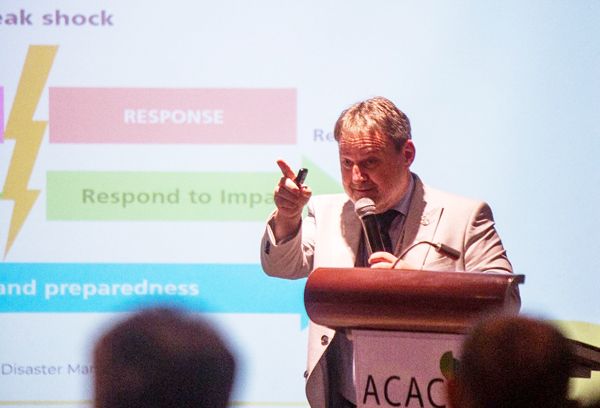DAVAO CITY – Since January this year, several provinces across Mindanao have experienced severe flooding due to heavy rains.

DR. Lionel Dabbadie, chief of the Food and Agriculture Organization in the Philippines. (Keith Bacongco)
Many of these inundated areas were not just simply low-lying areas but also among the top rice, corn, and vegetable producers in the region.
The massive flooding in agricultural areas may have a serious impact on the food security of the region, according to Dr. Lionel Dabbadie, chief of the Food and Agriculture Organization of the United Nations in the Philippines.
Dabbadie, who was in this city for the Mindanao Development Forum from July 24 to 25, said that the widespread flooding in Mindanao could have an adverse impact on food security of the region.
“The food security is a combination of the number of people and the production. Right now, the production has not been increasing so much practically due among many factors and flood is one of them,” he said.
In early February, a massive flood affected at least 20,000 hectares of rice farms in Agusan del Sur, Agusan del Norte, Davao del Norte, Davao de Oro, and Davao Oriental.
Hardest hit were the plains of Davao del Norte and Davao de Oro based on the report from the Department of Agriculture.
Following the flooding, many farmers in these areas were not able to resume rice production due to the onset of the dry spell.
Two weeks ago, at least 8,800 hectares of agricultural land have been damaged by the severe flooding in many parts of the Bangsamoro Autonomous Region in Muslim Mindanao.
The BARMM Rapid Emergency Action on Disaster Incidence (Bangsamoro READi) recorded that damage to the agriculture sector as of Wednesday, July 24, was estimated to be at least P338.5 million, affecting 11,500 farmers.
At least 186, 000 families from Basilan, Lanao del Sur, Maguindanao del Norte, and Maguindanao del Sur have been affected.
Hardest hit was Maguindanao del Sur which accounts for about half of the total affected families. It was also the same province that was placed under state of calamity last April to damage in agriculture amid the prolonged dry spell.
The severe flooding was due to the heavy rains as well as the swelling of the Pulangi River that stretches across Cotabato and Maguindanao del Sur.
Amid the widespread flooding, Dabbadie said that aside from the impact of natural disasters, poverty and the limited connectivity of food producers to the local market also contribute to the food security issues.
“If do not take into consideration the current limitations to the production, which includes poverty, the natural constraints like floods, it will have an impact on food security,” he said. “It is a combination of all factors, including the difficulty to reach the market.”
Due to poverty, the FAO official added, food producers do not have enough resources to produce high yield of rice. “There’s not a silver bullet to solve the problem. There’s no other way but include all the factors.”
Early this year, the National Anti-Poverty Commission (NAPC) reported that BARMM was the area with the highest poverty incidence in Mindanao.
Based on the family income and expenditures survey in 2022, poverty incidence was 16.4 percent.
Dabbadie also emphasized the cycle of displacement due to pocket clan wars in the region could affect food production as well.
“Displacement has consequence on the environment, consequence on the poverty level, consequence on food security. That’s the challenge.”
To address these obstacles, Dabbadie said that FAO is currently working with the local governments in institutionalizing the anticipatory action approach in the region.
He said the anticipatory action is an innovative approach that systematically links early warnings to a set of interventions aimed at protecting families and their assets ahead of a hazard.
This approach is now implemented in selected areas in BARMM and Cotabato, the FAO official said.
“As our chief in FAO said, we need to have better production, better nutrition, better environment, better lives, leaving no one behind. We need to do everything at the same time. It looks complicated but we have tools to do that,” Dabbadie said.